Moving to Korea: The Complete Guide - Part 1 (2025)
Got your visa in Korea? Time to move in! The first part of this guide series walks you through getting your local ID card, bank account, and phone number.
You have succeeded in getting a Digital Nomad visa or a Startup (OASIS) visa in Korea. Congratulations!
Next step? The fun stuff: administration.
We wrote a guide to help you with getting your Residence Card, setting up your phone number, and opening a bank account.
Is it the sexiest part of travelling? Not really, but we’re happy to make this journey a little simpler for you.
Here are the steps for the easiest transition:
- Get a temporary phone number
- Apply for your Residence Card and wait 2 to 4 weeks for it to arrive
- Open a bank account
- Get a verified phone number linked to your Residence Card
- Change your phone number at the bank to the new one
In total, including the wait for the Residence Card appointment and the wait for the card itself, this could take up to a month or a month and a half.
1. Get a temporary Korean phone number
This is the easiest step!
You’ll find that you need a phone number for many things in Korea, like making an appointment at the immigration office, getting a bank account... Delivery workers will often want to set up the delivery over the phone and/or by SMS.
You’ll also be asked for your number in surprising places. That’s because identity checks are linked to your phone number in Korea. This is key to understanding why the steps to move in must be executed in a certain order.
As a visa holder, you can get a verified number down the line (one that will let you pass the ID checks required to make an account on Korean websites), but not yet.
First, you have to get a pre-paid number tied to your passport by checking out our eSIM and SIM card guide.
If you don’t want to change number, services like Kimbap Mobile can handle all the phone admin for you (for more details check the guide). Then, you can skip step 5.
2. Get your local ID card
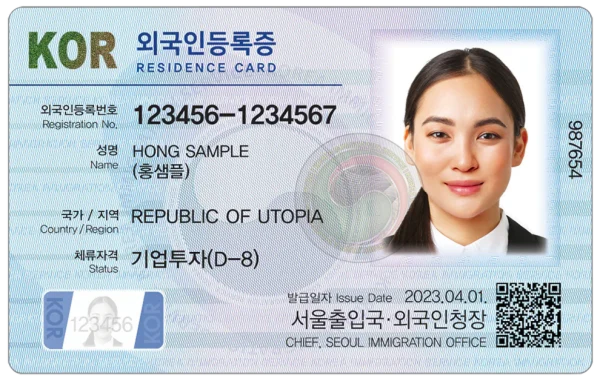
You have 90 days to get your Residence Card (still mostly known by its older name: Alien Registration Card, or ARC) once you ‘activate’ your visa. It doesn’t matter whether you have the Digital Nomad visa (F-1-D), the Startup visa (D-10-2, D-8-4), or the Working Holiday visa (H-1). You have to get it.
Step 1: Figure out your immigration office
You can't go to any immigration office. You can only make an appointment in the one that's in charge of the area you currently reside in.
Don't worry if it's a temporary adress, you can always change it later. To register the change, you'll have to go to the immigration office in charge of the new adress.
Most cities only have one immigration office, but in Seoul, there are a few. Refer to the following map to figure out which one is the right one for you.
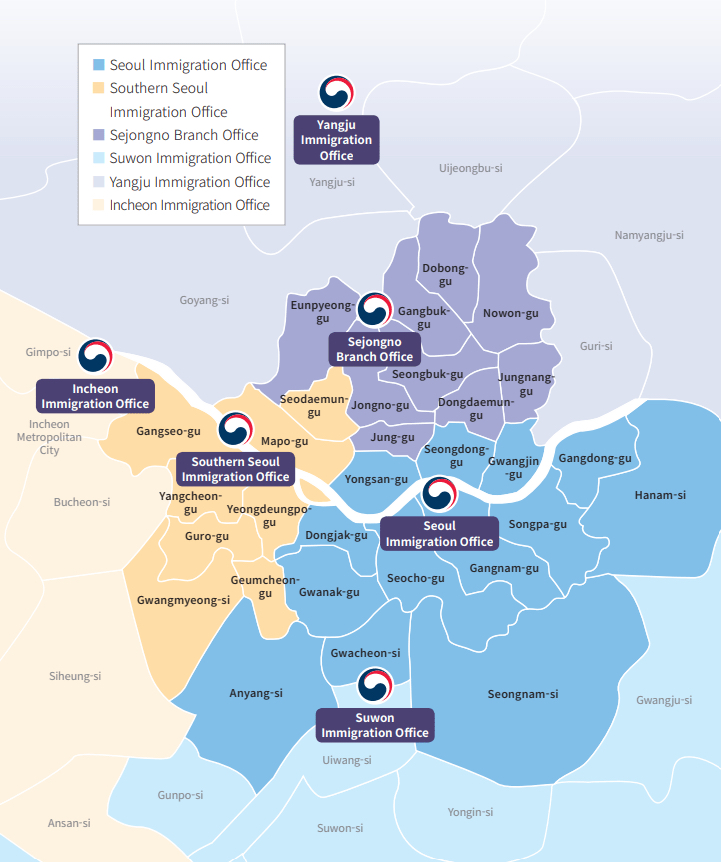
Step 2. Make the appointment on the HiKorea website
HiKorea is the official website for the immigration office. You can use it to apply for a visa and to make appointments.
Note: navigation on the English website is sometimes a bit finicky. Be patient if the website suddenly reverts to its Korean version, it happens 😅
- Click on ‘ENGLISH’ in the top right corner of the website.
- Hover over ‘Petition Application’ and click on ‘Reserve Visit’ in the menu.
- Select ‘Visit Reservation Application (Non-member)’ at the bottom of the page.

- Say ‘OK’ to the pop-up.
- Select the ‘Identity verification using passport number’ tab.
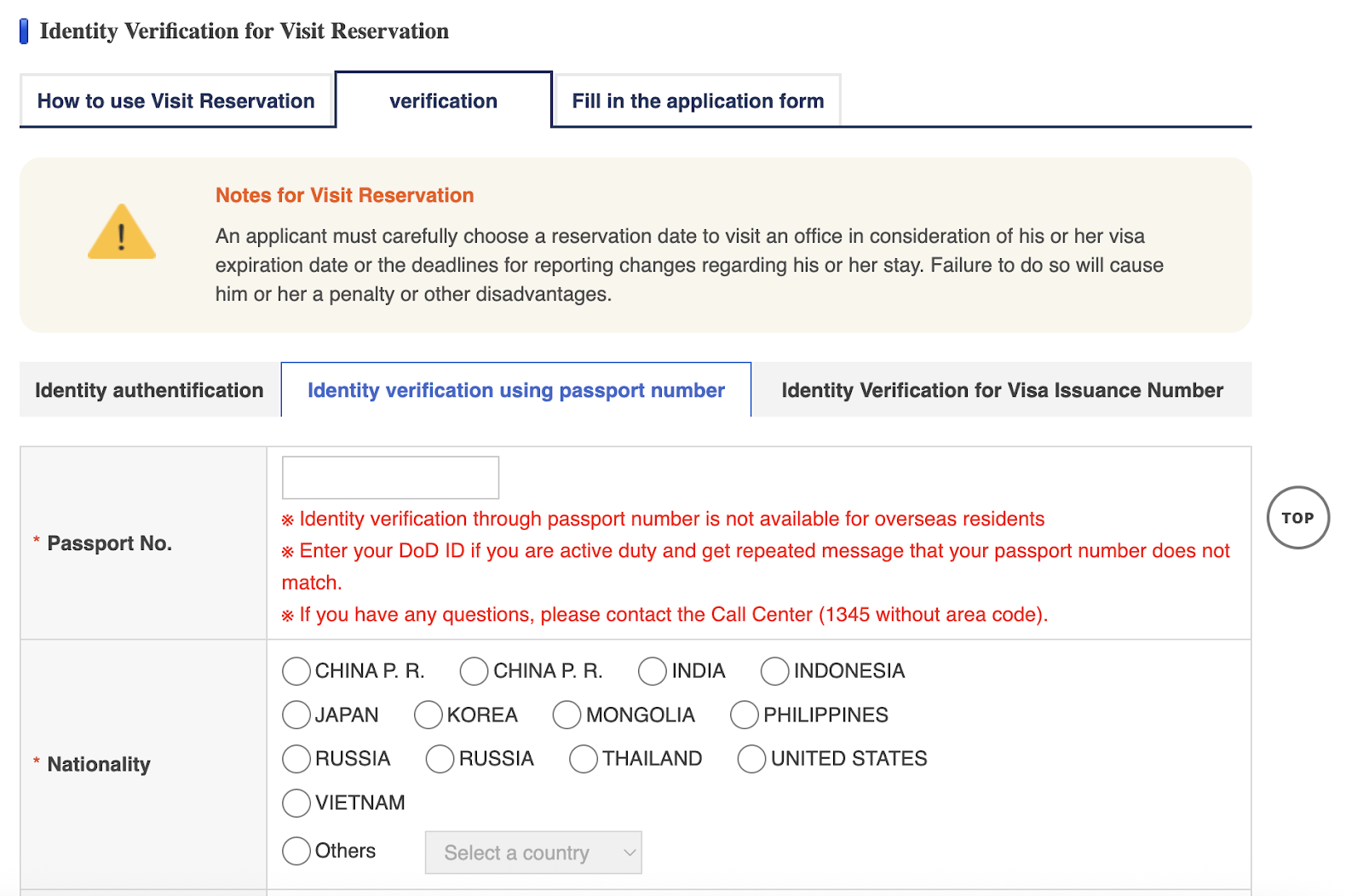
- Fill in the application form.
To register for the Resident Card, you have to select Foreign Resident Registration.
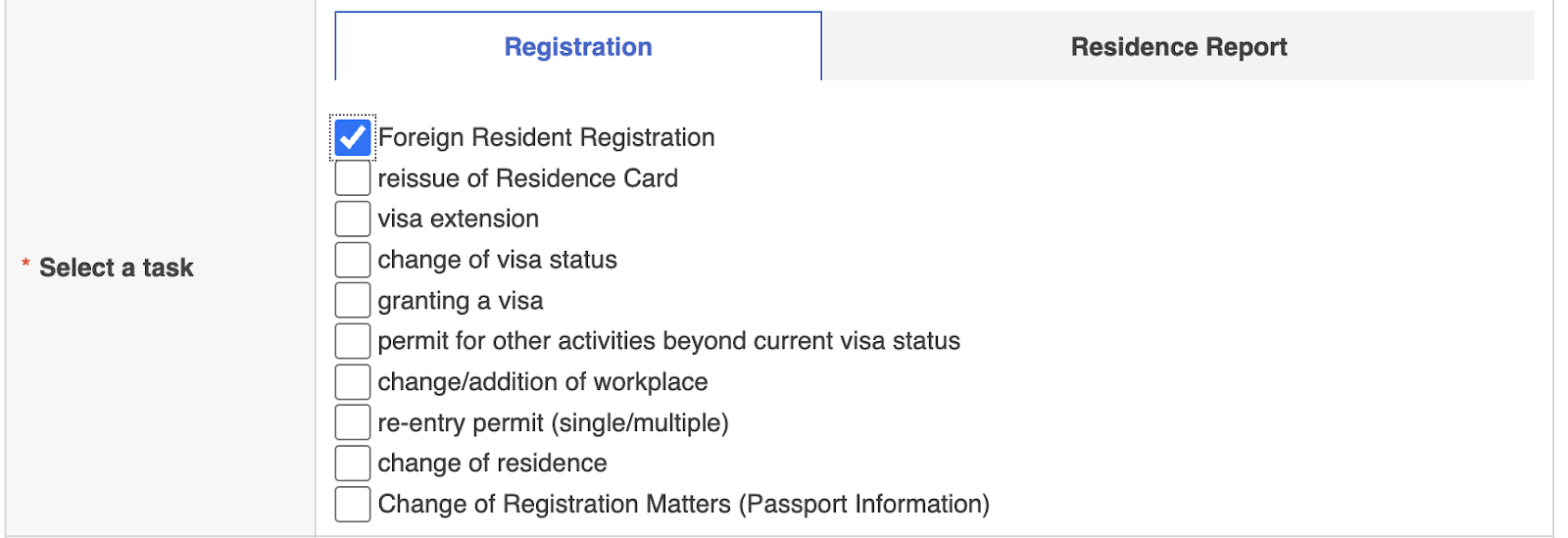
Then you’ll be asked for your Korean phone number.

Choose your time and date for the visit. Keep in mind immigration appointments are usually fully booked for a week or two. Sometimes, it's even three or four weeks when new school terms start (September/October and March/April).

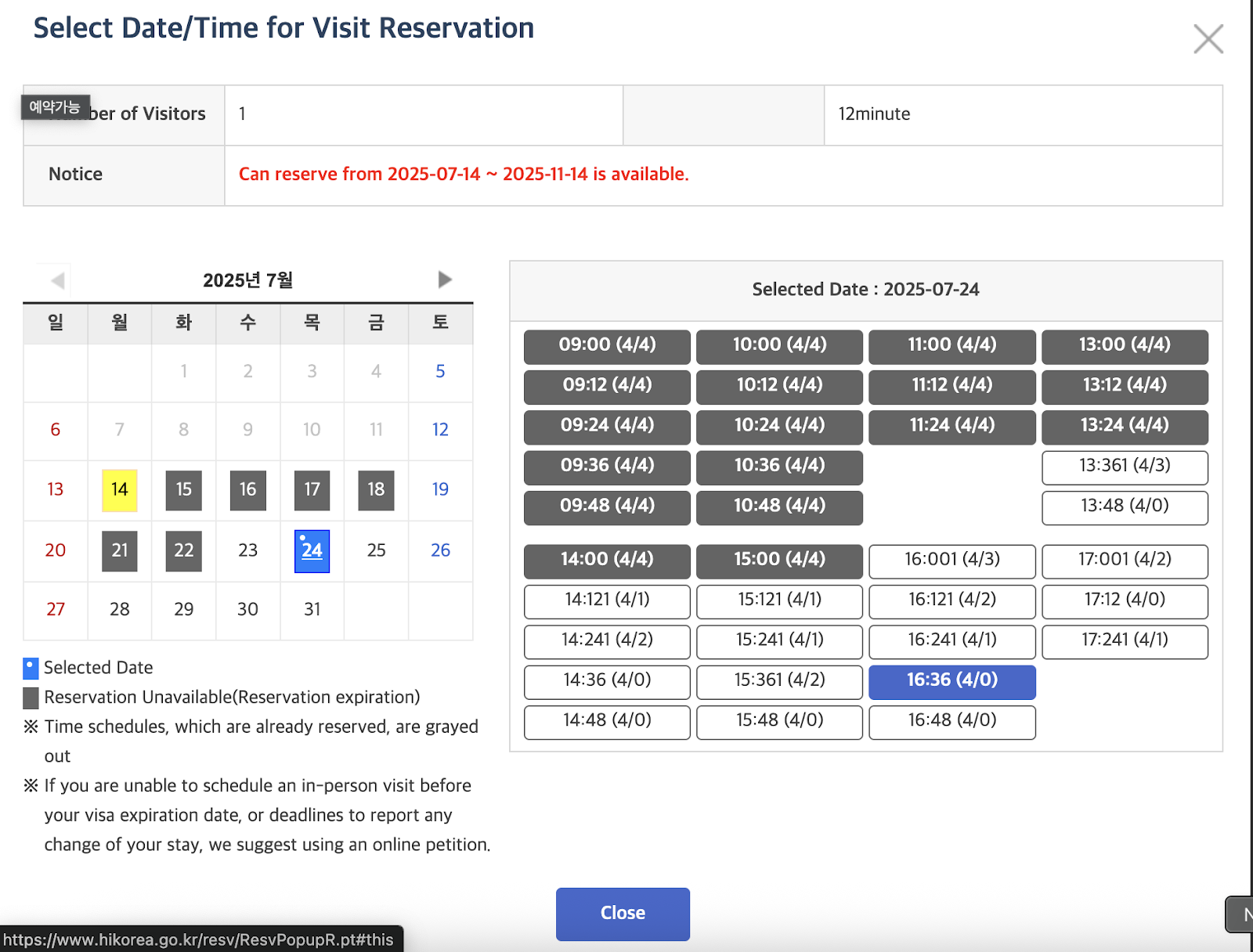
- Click on ‘Apply’.
Step 3: Bring the documents
- Application Form (download it on the website or get to immigration a bit earlier and fill it up there)
- Passport and a copy of the passport ID page
- Photo color (3.5x4.5 cm, not older than 6 months. You can take the picture at the immigration office. It costs around 10.000 wons in CASH.)
- Application Fee (35.000 wons in CASH + 4.000 wons if you want it delivered at home)
- Visa Grant Notice
- Proof of residence
Your proof of residence depends on your accommodation type.
Housing (Lease/Contract in Your Name)
- Housing contract (must include the exact address, your personal information, the landlord’s information, and signature, and the duration of your stay).
Gosiwon, Guesthouse, Airbnb, Shared House, etc.
- Confirmation of Residence/Accommodation or Accommodation Contract
- Business Registration Certificate of the accommodation (to verify the address)
- Receipt of Payment for your stay (bank transfer records can be used)
- For Airbnb: print the receipt page and submit it
Staying at a Friend’s or Someone Else’s House (Contract Not in Your Name)
- Confirmation of Residence/Accommodation (signed by the person you are staying with)
- Copy of the ID card (front and back) of the official tenant
- Copy of the housing contract (if the address on the ID doesn’t match)
Step 4. Wait for your ARC
It will take around 2 weeks for it to be made and sent. It can take up to a month, but it’s rare.
3. Open a bank account
You have a temporary phone number and your Residence Card - you can now open a bank account!
Note: The following information is based on the experiences of our community members who have successfully obtained the digital nomad and OASIS visas.
You can open a bank account anywhere in theory. But in practice, it might be difficult if you don’t speak Korean. We recommend choosing a bank with foreign or expat services (you can find this information online).
Tips from our community
- Be patient. The bank system in Korea can be a bit frustrating to navigate.
- Hana Bank has particularly good foreigner-friendly services (but our community members recommend not to go to their Itaewon branch).
- You will be asked if you want to do online banking when opening the account. Say YES. You won’t be able to do online banking in practice just yet, but don’t worry, it’s coming soon.
- Some banks only allow you to open an account in the branch responsible for the district you currently live in.
- Monday and Tuesday tend to be slower and less busy. You shouldn’t have to wait too long if you go early morning or before closing time.
- Bring your residence card and your passport to the appointment. If you want to raise your daily limits, bringing your rental contract and a pay slip could help your case.
4. Get your verified phone number
Finally, you’ll be able to make accounts on Korean apps and watch +19 year old videos on YouTube without a VPN!
This new post-paid number will be linked to your Residence Card, and you’ll pay the subscription with your Korean account. It will allow you to pass the dreaded ID verification check asked nearly everywhere online in Korea.
Refer to the ‘For Korean-speaking foreigners or residents’ section in our eSIM and SIM card guide to have an easier time choosing which carrier (LG, SKT, KT) is right for you.
If you went with Kimbap mobile in step 1, message them to ask to switch from pre-paid to post-paid. As soon as your number is activated, you can set up your online banking app.
5. Change your number with the bank
Depending on the bank of your choice, you can change the number on the app or in person.
Online banking unlocked! You can now access all Korean services all over the country - or nearly.
What's next?
You’re all set up with the basic admin… Time to find your long-term accommodation!
If you want to know more about living as a Digital Nomad in Korea, you can join our WhatsApp & Discord community and read the comprehensive guide we wrote on the topic!
Moving to Korea: The Complete Guide - Part 1 (2025)
Got your visa in Korea? Time to move in! The first part of this guide series walks you through getting your local ID card, bank account, and phone number.
You have succeeded in getting a Digital Nomad visa or a Startup (OASIS) visa in Korea. Congratulations!
Next step? The fun stuff: administration.
We wrote a guide to help you with getting your Residence Card, setting up your phone number, and opening a bank account.
Is it the sexiest part of travelling? Not really, but we’re happy to make this journey a little simpler for you.
Here are the steps for the easiest transition:
- Get a temporary phone number
- Apply for your Residence Card and wait 2 to 4 weeks for it to arrive
- Open a bank account
- Get a verified phone number linked to your Residence Card
- Change your phone number at the bank to the new one
In total, including the wait for the Residence Card appointment and the wait for the card itself, this could take up to a month or a month and a half.
1. Get a temporary Korean phone number
This is the easiest step!
You’ll find that you need a phone number for many things in Korea, like making an appointment at the immigration office, getting a bank account... Delivery workers will often want to set up the delivery over the phone and/or by SMS.
You’ll also be asked for your number in surprising places. That’s because identity checks are linked to your phone number in Korea. This is key to understanding why the steps to move in must be executed in a certain order.
As a visa holder, you can get a verified number down the line (one that will let you pass the ID checks required to make an account on Korean websites), but not yet.
First, you have to get a pre-paid number tied to your passport by checking out our eSIM and SIM card guide.
If you don’t want to change number, services like Kimbap Mobile can handle all the phone admin for you (for more details check the guide). Then, you can skip step 5.
2. Get your local ID card

You have 90 days to get your Residence Card (still mostly known by its older name: Alien Registration Card, or ARC) once you ‘activate’ your visa. It doesn’t matter whether you have the Digital Nomad visa (F-1-D), the Startup visa (D-10-2, D-8-4), or the Working Holiday visa (H-1). You have to get it.
Step 1: Figure out your immigration office
You can't go to any immigration office. You can only make an appointment in the one that's in charge of the area you currently reside in.
Don't worry if it's a temporary adress, you can always change it later. To register the change, you'll have to go to the immigration office in charge of the new adress.
Most cities only have one immigration office, but in Seoul, there are a few. Refer to the following map to figure out which one is the right one for you.

Step 2. Make the appointment on the HiKorea website
HiKorea is the official website for the immigration office. You can use it to apply for a visa and to make appointments.
Note: navigation on the English website is sometimes a bit finicky. Be patient if the website suddenly reverts to its Korean version, it happens 😅
- Click on ‘ENGLISH’ in the top right corner of the website.
- Hover over ‘Petition Application’ and click on ‘Reserve Visit’ in the menu.
- Select ‘Visit Reservation Application (Non-member)’ at the bottom of the page.

- Say ‘OK’ to the pop-up.
- Select the ‘Identity verification using passport number’ tab.

- Fill in the application form.
To register for the Resident Card, you have to select Foreign Resident Registration.

Then you’ll be asked for your Korean phone number.

Choose your time and date for the visit. Keep in mind immigration appointments are usually fully booked for a week or two. Sometimes, it's even three or four weeks when new school terms start (September/October and March/April).


- Click on ‘Apply’.
Step 3: Bring the documents
- Application Form (download it on the website or get to immigration a bit earlier and fill it up there)
- Passport and a copy of the passport ID page
- Photo color (3.5x4.5 cm, not older than 6 months. You can take the picture at the immigration office. It costs around 10.000 wons in CASH.)
- Application Fee (35.000 wons in CASH + 4.000 wons if you want it delivered at home)
- Visa Grant Notice
- Proof of residence
Your proof of residence depends on your accommodation type.
Housing (Lease/Contract in Your Name)
- Housing contract (must include the exact address, your personal information, the landlord’s information, and signature, and the duration of your stay).
Gosiwon, Guesthouse, Airbnb, Shared House, etc.
- Confirmation of Residence/Accommodation or Accommodation Contract
- Business Registration Certificate of the accommodation (to verify the address)
- Receipt of Payment for your stay (bank transfer records can be used)
- For Airbnb: print the receipt page and submit it
Staying at a Friend’s or Someone Else’s House (Contract Not in Your Name)
- Confirmation of Residence/Accommodation (signed by the person you are staying with)
- Copy of the ID card (front and back) of the official tenant
- Copy of the housing contract (if the address on the ID doesn’t match)
Step 4. Wait for your ARC
It will take around 2 weeks for it to be made and sent. It can take up to a month, but it’s rare.
3. Open a bank account
You have a temporary phone number and your Residence Card - you can now open a bank account!
Note: The following information is based on the experiences of our community members who have successfully obtained the digital nomad and OASIS visas.
You can open a bank account anywhere in theory. But in practice, it might be difficult if you don’t speak Korean. We recommend choosing a bank with foreign or expat services (you can find this information online).
Tips from our community
- Be patient. The bank system in Korea can be a bit frustrating to navigate.
- Hana Bank has particularly good foreigner-friendly services (but our community members recommend not to go to their Itaewon branch).
- You will be asked if you want to do online banking when opening the account. Say YES. You won’t be able to do online banking in practice just yet, but don’t worry, it’s coming soon.
- Some banks only allow you to open an account in the branch responsible for the district you currently live in.
- Monday and Tuesday tend to be slower and less busy. You shouldn’t have to wait too long if you go early morning or before closing time.
- Bring your residence card and your passport to the appointment. If you want to raise your daily limits, bringing your rental contract and a pay slip could help your case.
4. Get your verified phone number
Finally, you’ll be able to make accounts on Korean apps and watch +19 year old videos on YouTube without a VPN!
This new post-paid number will be linked to your Residence Card, and you’ll pay the subscription with your Korean account. It will allow you to pass the dreaded ID verification check asked nearly everywhere online in Korea.
Refer to the ‘For Korean-speaking foreigners or residents’ section in our eSIM and SIM card guide to have an easier time choosing which carrier (LG, SKT, KT) is right for you.
If you went with Kimbap mobile in step 1, message them to ask to switch from pre-paid to post-paid. As soon as your number is activated, you can set up your online banking app.
5. Change your number with the bank
Depending on the bank of your choice, you can change the number on the app or in person.
Online banking unlocked! You can now access all Korean services all over the country - or nearly.
What's next?
You’re all set up with the basic admin… Time to find your long-term accommodation!
If you want to know more about living as a Digital Nomad in Korea, you can join our WhatsApp & Discord community and read the comprehensive guide we wrote on the topic!
Moving to Korea: The Complete Guide - Part 1 (2025)
Got your visa in Korea? Time to move in! The first part of this guide series walks you through getting your local ID card, bank account, and phone number.
You have succeeded in getting a Digital Nomad visa or a Startup (OASIS) visa in Korea. Congratulations!
Next step? The fun stuff: administration.
We wrote a guide to help you with getting your Residence Card, setting up your phone number, and opening a bank account.
Is it the sexiest part of travelling? Not really, but we’re happy to make this journey a little simpler for you.
Here are the steps for the easiest transition:
- Get a temporary phone number
- Apply for your Residence Card and wait 2 to 4 weeks for it to arrive
- Open a bank account
- Get a verified phone number linked to your Residence Card
- Change your phone number at the bank to the new one
In total, including the wait for the Residence Card appointment and the wait for the card itself, this could take up to a month or a month and a half.
1. Get a temporary Korean phone number
This is the easiest step!
You’ll find that you need a phone number for many things in Korea, like making an appointment at the immigration office, getting a bank account... Delivery workers will often want to set up the delivery over the phone and/or by SMS.
You’ll also be asked for your number in surprising places. That’s because identity checks are linked to your phone number in Korea. This is key to understanding why the steps to move in must be executed in a certain order.
As a visa holder, you can get a verified number down the line (one that will let you pass the ID checks required to make an account on Korean websites), but not yet.
First, you have to get a pre-paid number tied to your passport by checking out our eSIM and SIM card guide.
If you don’t want to change number, services like Kimbap Mobile can handle all the phone admin for you (for more details check the guide). Then, you can skip step 5.
2. Get your local ID card

You have 90 days to get your Residence Card (still mostly known by its older name: Alien Registration Card, or ARC) once you ‘activate’ your visa. It doesn’t matter whether you have the Digital Nomad visa (F-1-D), the Startup visa (D-10-2, D-8-4), or the Working Holiday visa (H-1). You have to get it.
Step 1: Figure out your immigration office
You can't go to any immigration office. You can only make an appointment in the one that's in charge of the area you currently reside in.
Don't worry if it's a temporary adress, you can always change it later. To register the change, you'll have to go to the immigration office in charge of the new adress.
Most cities only have one immigration office, but in Seoul, there are a few. Refer to the following map to figure out which one is the right one for you.

Step 2. Make the appointment on the HiKorea website
HiKorea is the official website for the immigration office. You can use it to apply for a visa and to make appointments.
Note: navigation on the English website is sometimes a bit finicky. Be patient if the website suddenly reverts to its Korean version, it happens 😅
- Click on ‘ENGLISH’ in the top right corner of the website.
- Hover over ‘Petition Application’ and click on ‘Reserve Visit’ in the menu.
- Select ‘Visit Reservation Application (Non-member)’ at the bottom of the page.

- Say ‘OK’ to the pop-up.
- Select the ‘Identity verification using passport number’ tab.

- Fill in the application form.
To register for the Resident Card, you have to select Foreign Resident Registration.

Then you’ll be asked for your Korean phone number.

Choose your time and date for the visit. Keep in mind immigration appointments are usually fully booked for a week or two. Sometimes, it's even three or four weeks when new school terms start (September/October and March/April).


- Click on ‘Apply’.
Step 3: Bring the documents
- Application Form (download it on the website or get to immigration a bit earlier and fill it up there)
- Passport and a copy of the passport ID page
- Photo color (3.5x4.5 cm, not older than 6 months. You can take the picture at the immigration office. It costs around 10.000 wons in CASH.)
- Application Fee (35.000 wons in CASH + 4.000 wons if you want it delivered at home)
- Visa Grant Notice
- Proof of residence
Your proof of residence depends on your accommodation type.
Housing (Lease/Contract in Your Name)
- Housing contract (must include the exact address, your personal information, the landlord’s information, and signature, and the duration of your stay).
Gosiwon, Guesthouse, Airbnb, Shared House, etc.
- Confirmation of Residence/Accommodation or Accommodation Contract
- Business Registration Certificate of the accommodation (to verify the address)
- Receipt of Payment for your stay (bank transfer records can be used)
- For Airbnb: print the receipt page and submit it
Staying at a Friend’s or Someone Else’s House (Contract Not in Your Name)
- Confirmation of Residence/Accommodation (signed by the person you are staying with)
- Copy of the ID card (front and back) of the official tenant
- Copy of the housing contract (if the address on the ID doesn’t match)
Step 4. Wait for your ARC
It will take around 2 weeks for it to be made and sent. It can take up to a month, but it’s rare.
3. Open a bank account
You have a temporary phone number and your Residence Card - you can now open a bank account!
Note: The following information is based on the experiences of our community members who have successfully obtained the digital nomad and OASIS visas.
You can open a bank account anywhere in theory. But in practice, it might be difficult if you don’t speak Korean. We recommend choosing a bank with foreign or expat services (you can find this information online).
Tips from our community
- Be patient. The bank system in Korea can be a bit frustrating to navigate.
- Hana Bank has particularly good foreigner-friendly services (but our community members recommend not to go to their Itaewon branch).
- You will be asked if you want to do online banking when opening the account. Say YES. You won’t be able to do online banking in practice just yet, but don’t worry, it’s coming soon.
- Some banks only allow you to open an account in the branch responsible for the district you currently live in.
- Monday and Tuesday tend to be slower and less busy. You shouldn’t have to wait too long if you go early morning or before closing time.
- Bring your residence card and your passport to the appointment. If you want to raise your daily limits, bringing your rental contract and a pay slip could help your case.
4. Get your verified phone number
Finally, you’ll be able to make accounts on Korean apps and watch +19 year old videos on YouTube without a VPN!
This new post-paid number will be linked to your Residence Card, and you’ll pay the subscription with your Korean account. It will allow you to pass the dreaded ID verification check asked nearly everywhere online in Korea.
Refer to the ‘For Korean-speaking foreigners or residents’ section in our eSIM and SIM card guide to have an easier time choosing which carrier (LG, SKT, KT) is right for you.
If you went with Kimbap mobile in step 1, message them to ask to switch from pre-paid to post-paid. As soon as your number is activated, you can set up your online banking app.
5. Change your number with the bank
Depending on the bank of your choice, you can change the number on the app or in person.
Online banking unlocked! You can now access all Korean services all over the country - or nearly.
What's next?
You’re all set up with the basic admin… Time to find your long-term accommodation!
If you want to know more about living as a Digital Nomad in Korea, you can join our WhatsApp & Discord community and read the comprehensive guide we wrote on the topic!



